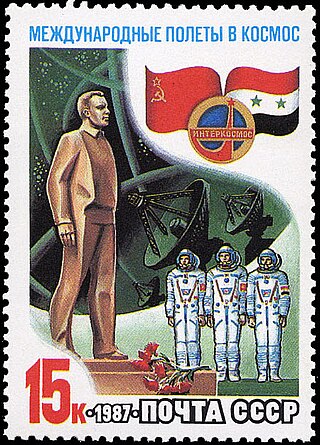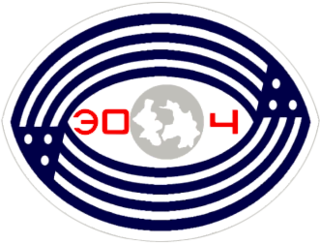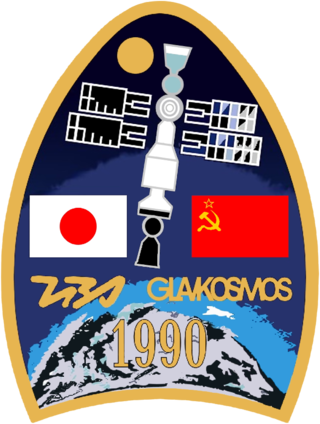
Mir was a space station that operated in low Earth orbit from 1986 to 2001, operated by the Soviet Union and later by Russia. Mir was the first modular space station and was assembled in orbit from 1986 to 1996. It had a greater mass than any previous spacecraft. At the time it was the largest artificial satellite in orbit, succeeded by the International Space Station (ISS) after Mir's orbit decayed. The station served as a microgravity research laboratory in which crews conducted experiments in biology, human biology, physics, astronomy, meteorology, and spacecraft systems with a goal of developing technologies required for permanent occupation of space.

Anatoly Yakovlevich Solovyev is a retired Russian and Soviet cosmonaut and pilot. Solovyev was born on January 16, 1948, in Riga, Latvia. Solovyev holds the world record on the number of spacewalks performed (16), and accumulated time spent spacewalking.

Yury Vladimirovich Usachov is a former cosmonaut who resides in Star City, Moscow. Usachov is a veteran of four spaceflights, including two long-duration missions on board the Mir Space Station and another on board the International Space Station. During his career, he also conducted seven spacewalks before his retirement on April 5, 2004.

Soyuz T-12 was the seventh crewed spaceflight to the Soviet space station Salyut 7. The name "Soyuz T-12" is also the name of the spacecraft used to launch and land the mission's three-person crew. The mission occurred in July 1984, during the long-duration expedition Salyut 7 EO-3. During the mission, crew member Svetlana Savitskaya became the first woman to ever perform a spacewalk, and the potential Buran space shuttle pilot, Igor Volk, was given spaceflight experience. Unlike many Soyuz visiting missions, the Soyuz lifeboats were not swapped, and the crew returned to Earth in the same spacecraft in which they launched.

Soyuz T-15 was a crewed mission to the Mir and Salyut 7 space stations and was part of the Soyuz programme. It marked the final flight of the Soyuz-T spacecraft, the third generation Soyuz spacecraft, which had been in service for seven years from 1979 to 1986. This mission marked the first time that a spacecraft visited, and docked with, two space stations in the same mission.

Soyuz TM-2 was a crewed spaceflight to the Soviet space station Mir, which was uncrewed at the time. TM-2 was launched on February 5, 1987, and it was first crewed spaceflight of the Soyuz-TM spacecraft, and the second crewed spaceflight to Mir. The crew of the long duration expedition, Mir EO-2, who were launched by TM-2 consisted of Soviet cosmonauts Yuri Romanenko and Aleksandr Laveykin.

Soyuz TM-3 was the third crewed spaceflight to visit the Soviet space station Mir, following Soyuz T-15 and Soyuz TM-2. It was launched in July 1987, during the long duration expedition Mir EO-2, and acted as a lifeboat for the second segment of that expedition. There were three people aboard the spacecraft at launch, including the two man crew of the week-long mission Mir EP-1, consisting of Soviet cosmonaut Aleksandr Viktorenko and Syrian Muhammed Faris. Faris was the first Syrian to travel to space, and as of June 2021, the only one. The third cosmonaut launched was Aleksandr Aleksandrov, who would replace one of the long duration crew members Aleksandr Laveykin of Mir EO-2. Laveykin had been diagnosed by ground-based doctors to have minor heart problems, so he returned to Earth with the EP-1 crew in Soyuz TM-2.

Soyuz TM-4 was a crewed Soyuz spaceflight to Mir. It was launched on 21 December 1987, and carried the first two crew members of the third long duration expedition, Mir EO-3. These crew members, Vladimir Titov and Musa Manarov, would stay in space for just under 366 days, setting a new spaceflight record. The third astronaut launched by Soyuz TM-4 was Anatoli Levchenko, who returned to Earth about a week later with the remaining crew of Mir EO-2. Levchenko was a prospective pilot for the Soviet Space shuttle Buran. The purpose of his mission, named Mir LII-1, was to familiarize him with spaceflight.

Soyuz TM-7 was a crewed Soyuz spaceflight to Mir. It launched on 26 November 1988, at 15:49:34, and was the start of the fourth long duration expedition to Mir, Mir EO-4. The crew would join the third crew member of EO-4, cosmonaut/physician Valeri Polyakov, who was on Mir for the second half of EO-3. Also launched by Soyuz TM-7 was French astronaut Jean-Loup Chrétien, who would take part in the 24-day French mission known as Mir Aragatz. The spacecraft Soyuz TM-7 remained docked to Mir for the duration of EO-4. At the end of EO-4 in April 1989, due to delays in the launch schedule, Mir was left uncrewed, and all three EO-4 crew members were transported back to Earth.

Soyuz TM-8 was a 1989 spaceflight which carried the fifth long duration crew to the Soviet space station Mir. It was part of the Soyuz-TM series of spacecraft, which were the fourth generation of the Soviet Soyuz. Soyuz TM-8 was the eighth crewed spaceflight to Mir, and spent 166 days in orbit.

Soyuz TM-21 was a crewed Soyuz spaceflight to Mir. The mission launched from Baikonur Cosmodrome, atop a Soyuz-U2 carrier rocket, at 06:11:34 UTC on March 14, 1995. The flight marked the first time thirteen humans were flying in space simultaneously, with three aboard the Soyuz, three aboard Mir and seven aboard Space Shuttle Endeavour, flying STS-67.

Soyuz TM-23 was a Soyuz spaceflight which launched on February 21, 1996, to Mir. The spacecraft launched from Baikonur Cosmodrome, and after two days of flight, Yuri Onufrienko and Yury Usachov docked with Mir and became the 21st resident crew of the Station. On September 2, 1996, after 191 days docked with Mir, the ship undocked with the launch crew and Claudie André-Deshays onboard, before eventually landing 107 km (66 mi) south west of Akmola, Kazakhstan.

Soyuz TM-30, also known as Mir EO-28, was a Soyuz mission, the 39th and final human spaceflight to the Mir space station. The crew of the mission was sent by MirCorp, a privately funded company, to reactivate and repair the station. The crew also resupplied the station and boosted the station to an orbit with a low point (perigee) of 360 and a high point (apogee) of 378 kilometers ; the boost in the station's orbit was done by utilizing the engines of the Progress M1-1 and M1-2 spacecraft. At that time a transit between Mir and the International Space Station was already impossible - such a transfer was deemed undesired by NASA - and the orbital plane of ISS had been chosen some time before to be around 120 degrees away from that of Mir. The mission was the first privately funded mission to a space station.
Mir EO-3 was an expedition to the space station Mir. The crew consisted of 3 people, Musa Manarov (Commander), Vladimir Titov and Valeri Polyakov. Manarov and Titov arrived at the station in December 1987 on Soyuz TM-4, while Polyakov arrived much later, in August 1988 on Soyuz TM-6. After the arrival of Polyakov, medical experiments became more intensive.

Mir EO-4 was the fourth long-duration expedition to the Soviet space station Mir. The expedition began in November 1988, when crew members Commander Aleksandr Volkov and Flight Engineer Sergei Krikalev arrived at the station via the spacecraft Soyuz TM-7. The third crew member of EO-4, Valeri Polyakov, was already aboard Mir, having arrived in August 1988 part way through the previous expedition, Mir EO-3.

Mir EO-2 was the second long duration expedition to the Soviet space station Mir, and it lasted from February to December 1987. The mission was divided into two parts, the division occurring when one of the two crew members, Aleksandr Laveykin, was replaced part way through the mission by Aleksandr Aleksandrov. Laveykin was replaced because ground-based doctors had diagnosed him with minor heart problems.

Mir EP-2 was a visiting expedition to the Mir space station conducted in June 1988 by cosmonauts Anatoly Solovyev, Viktor Savinykh and Aleksandr Aleksandrov. Launched aboard the Soyuz TM-5 spacecraft, the crew spent ten days in space before returning to Earth aboard Soyuz TM-4. The mission occurred while the EO-3 crew were aboard Mir.

Mir EO-19 was the nineteenth crewed expedition to the space station Mir, lasting from June to September 1995. The crew, consisting of Russian cosmonauts Anatoly Solovyev and Nikolai Budarin, launched on June 27, 1995 aboard the Space Shuttle Atlantis on the STS-71 mission. After remaining aboard Mir for approximately 75 days, Solovyev and Budarin returned aboard the Soyuz TM-21 spacecraft on September 11, 1995.

Mir EO-8 was the eighth crewed expedition to the space station Mir, lasting from December 1990 to May 1991. The crew, consisting of Russian cosmonauts Viktor Afanasyev and Musa Manarov, launched along with space journalist Toyohiro Akiyama on December 2, 1990 aboard Soyuz TM-11. Akiyama returned aboard Soyuz TM-10 with the outgoing Mir EO-7 crew on December 10. Afanasyev and Manarov returned aboard Soyuz TM-11 on May 26, 1991.
Mir EO-12 was the twelfth manned expedition to the space station Mir, lasting from July 1992 until February 1993. The crew, consisting of Russian cosmonauts Anatoly Solovyev and Sergei Avdeyev launched aboard Soyuz TM-15 on 27 July 1992 with French Research Cosmonaut Michel Tognini. After remaining on board Mir for just over six months, Solovyev and Avdeyev returned aboard the same spacecraft on 1 February 1993.
















